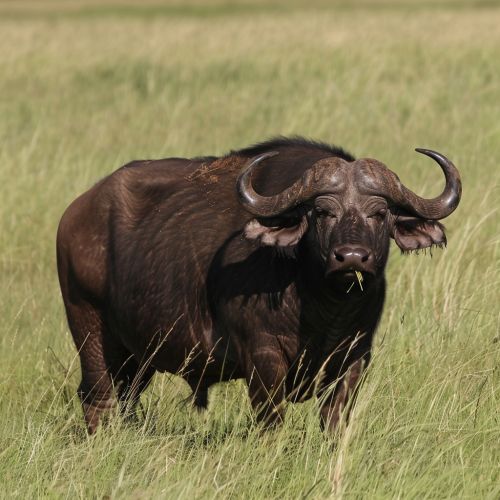Cape Buffalo
Classification and Description
The Cape buffalo (Syncerus caffer), also known as the African buffalo, is a large African bovine. It is not closely related to the slightly larger wild water buffalo of Asia and its ancestry remains unclear. The Cape buffalo is one of the most successful grazers in Africa. It lives in swamps and floodplains, as well as grasslands and forests of the major mountains of Africa. Cape buffalo can be found from the highest mountains to sea level areas, and prefer habitat with dense cover such as reeds and thickets.


Physical Characteristics
The Cape buffalo is a robust species. Its shoulder height can range from 1 to 1.7 meters (3.3 to 5.6 ft) and its head-and-body length can range from 1.7 to 3.4 meters (5.6 to 11.2 ft). The tail can range from 70 to 110 cm (28 to 43 in) long. Savannah-type buffaloes weigh 500 to 1,000 kg (1,100 to 2,200 lb), with males, normally larger than females, reaching the upper weight range. Forest-type buffaloes are only half that size.
Behavior and Ecology
Cape buffalo are highly social animals, forming herds of up to several thousand individuals. These herds are composed of smaller family groups, which include females and their offspring, as well as subordinate males. Dominant males, also known as bulls, maintain their status through displays of aggression and fights for dominance.
Diet
The Cape buffalo is a ruminant, and spends most of its day grazing on grasses. It requires a high quality diet, and will move great distances in search of suitable forage. During the dry season, when grasses are less available, the buffalo will also eat leaves and branches.
Reproduction
The breeding season of the Cape buffalo is not strictly defined, and calves can be born at any time of year. However, there is a peak in births in the rainy season, when food is more abundant. After a gestation period of approximately 11.5 months, a single calf is born. The calf remains hidden in vegetation for the first few weeks of its life, before joining the main herd.
Threats and Conservation
The Cape buffalo is listed as Least Concern by the IUCN, due to its wide distribution and large population. However, it faces threats from habitat loss and hunting. In some areas, the buffalo is also at risk from diseases such as bovine tuberculosis and foot-and-mouth disease.
Human Interaction
Cape buffalo are considered one of the most dangerous animals in Africa, and are responsible for killing more hunters on the continent than any other creature. They are known to charge with remarkable speed and agility, and are highly unpredictable.
